Flag Hoist/Radio Call Sign: November - Kilo - X-Ray - Yankee


|
||
 |
Originally classified AVG-83, was reclassified ACV-83 on 20 August1942,
allocated to Great Britain, under Lend Lease, on 11 November,
reallocated to the United States on 21 June 1943; reclassified CVE-83
on 15 July. laid down on 8 November 1943; launched on
31 January 1944, and commissioned on 9 March 1944.
Decommissioned to reserve on 23 July 1946.
Reclassified "Utility Aircraft Carrier" and redesignated CVU-83 on 12 June 1955, while in
reserve.
FATE Struck from the Navy list on 27 June 1958
| Click On Image For Full Size Image |
Size | Image Description | Contributed By And/Or Copyright |
|
|---|---|---|---|---|
| Name |
||||
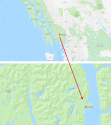 NS0308320 |
174k | AVG-83 (later ACV-83, CVE-83 and CVU-83) was named Sargent Bay for an estuary off Behm Canal, between Cactus and Tramp Points, on the east coast of Revillagigedo Island (opposite Rudyerd Bay), Alexander Archipelago, Alaska (NS0308320). Sargent Bay was a local navigators' name obtained in 1904 by Henry Clifford Fassett, U.S. Bureau of Fisheries. (Map courtesy of Google Maps.) |
NavSource | |
| Construction |
||||
 NS0308309 |
18k | Mrs. Rissie Farrnick of the Salvage shop, flower girl, presents flowers to the sponsor. Sargent Bay, Vancouver's 29th escort carrier, was launched on Monday, January 31, 1944 and sponsored by Mrs. Edith W. DeBaun, wife of Captain George H. DeBaun, a ranking naval flier. Attendants were Mrs. O. M. Mikkelson, matron of honor, and Mrs. Farrnick.
(From "Bo's'n's Whistle," Vol. 4, No. 3; February 11, 1944; page 7.) |
Courtesy of Ron Gough, Bea Dee, Ltd., Kaiser Vancouver / Swan Island & Oregon Shipyards website |
|
| World War II |
||||
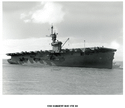 NS0308312 |
186k | Commissioned on 9 March 1944, USS Sargent Bay (CVE-83) is being moved by tugs at the Kaiser Shipbuilding Yard at Vancouver, Washington, 25th March. Susan Weikel Morrison, daughter of LT Weikel, comments:
|
Mike Green Tommy Trampp |
|
 NS0308319 |
113k | Undated overhead view of USS Sargent Bay (CVE-83) during World War II. Courtesy of William H. Davis, 1976. Naval History and Heritage Command, photo # NH 84836. |
Mike Green | |
 NS0308322 |
213k | Undated photo of an FG-1D Corsair launching from USS Sargent Bay (CVE-83). |
Tommy Trampp | |
 NS0308315 |
159k | Undated photo of FM Wildcats on patrol. |
Jerry Wintermute | |
 NS0308310 |
81k | USS Sargent Bay (CVE-83) at anchor, circa 1944, location unknown. USN photo. |
Robert Hurst | |
 NS0308316 |
276k | Bow and stern views, 30 May 1944, off the California coast. Painted in Measure 32, Design 15A camouflage. Part of the 40-mm AA battery is under tarpaulins. |
Gerd Matthes, Germany | |
 NS0308316a |
213k | Aerial view of USS Sargent Bay (CVE-83) at San Pedro, 30 May 1944, wearing camouflage scheme Measure 32, Design 15A. The colors are dull black, ocean gray and light gray with some pale gray for counter shading. National Archives and Records Administration (NARA) photo # 19-LCM-CVE83-1. |
Courtesy of C. Lee Johnson, usndazzle.com, via Mike Green |
|
 NS0308301 |
65k | This is a photo of FM-2 Wildcat D-12. It has just crashed into the barrier on USS Sargent Bay (CVE-83). The date is August 27, 1944. The pilot was LT(JG) Bob Hambley of VC-79. He survived the crash,and is still with us. |
Frank Harmon | |
 NS0308305 |
182k | USS Sargent Bay (CVE-83) underway, 250 miles from the Philippines, 1,000 feet height, 26 October 1944. Sargent Bay was camouflaged in Measure 32, Design 15A (thanks to Aryeh Wetherhorn.) |
Jerry Wintermute | |
|
Note: The original mount card caption has Bismarck Sea listed as Bismark Bay (CVE-59), which is incorrect. CVE-59 was USS Mission Bay and was off Africa at this time. CVE-95 was named Bismarck Sea. Both Sargent Bay and Bismarck Sea were in the Pacific. Sargent Bay's War Diary reads:
National Archives and Records Administration (NARA) photos. |
||||
 NS0308326 |
905k | Commander Eddie Peabody, playing the banjo (right) is shown aboard USS Sargent Bay (CVE-83), 14 November 1944. National Archives and Records Administration (NARA), photo # 80-G-263895. |
NARA | |
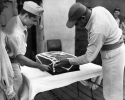 NS0308327 |
423k | Cake-cutting ceremony to celebrate the 1,000th landing on USS Sargent Bay (CVE-83), made by Ensign Thomas L. Clary, Jr., A-V(N), USNR, Composite Squadron (VC) 79, 28 November 1944. The 1,000th landing on the ship was made by ENS Clary on 25 October, but due to the carrier's anchorage for three weeks thereafter, and exigencies of war, the ceremony had to be deferred. National Archives and Records Administration (NARA), photo # 80-G-263901. |
NARA | |
 NS0308328 |
554k | A Christmas program on hangar deck of USS Sargent Bay (CVE-83) during "Happy Hour," 24 December 1944. National Archives and Records Administration (NARA), photo # 80-G-263928. |
NARA | |
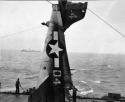 NS0308330 |
651k | Barrier crash of FM-2 Wildcat, D-4, Bu# 47301, Composite Squadron (VC) 79, on the flight deck of USS Sargent Bay (CVE-83), 20 January 1945. Pilot was Lieutenant Robert M. Johnson. National Archives and Records Administration (NARA), photo # 80-G-263975. |
NARA | |
 NS0308314 |
103k | Composite Squadron (VC) 79 plane over the side. VC-79 operated from USS Sargent Bay (CVE-83) between March 1944 and February 1945. |
Jerry Wintermute | |
 NS0308329 |
1.09M | USS Robert F. Keller (DE-419) collided with USS Sargent Bay (CVE-83), 3 January 1945. Sargent Bay's War Diary reads: At 1516 U.S.S. Robert F. Keller, by direction of OTC, made approach to deliver official mail. During the approach the DE struck the side of this ship aft of frame 126, directly below the main deck. A 16" hole between frames 125 and 126, three feet (3') below the main deck, resulted. National Archives and Records Administration (NARA) photo, # 80-G-263933. |
NARA | |
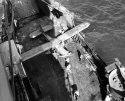 NS0308331 |
650k | Loading two Marine OY-1 Sentinels aboard USS Sargent Bay (CVE-83) at Saipan, Mariana Islands, 13 February 1945. From the ship's War Diary: In order to load two OY-1 aircraft aboard, by arrangement of COMPHIBSPAC representative with CTU 94.4.2, it was necessary, because of unfavorable sea condition in the outer harbor, for the ship to get underway and anchor in berth L-51, Saipan inner harbor, where the planes were received from an LCT. NS0308331: National Archives and Records Administration (NARA) photo, # 80-G-264005. NS0308331a: National Archives and Records Administration (NARA) photo, # 80-G-264006. NS0308331b: National Archives and Records Administration (NARA) photo, # 80-G-264007. |
NARA | |
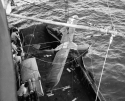 NS0308331a |
715k | |||
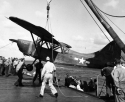 NS0308331b |
429k | |||
 NS0308313 |
210k | Chichi Jima, Bonin Islands (Ogasawara Gunto), on 16 February 1945, under attack by aircraft from Task Group 52.2 (including Sargent Bay's VC-79), and in 2009. |
Jerry Wintermute | |
 NS0308313a |
302k | |||
 NS0308321 |
1.17M | Aboard USS Sargent Bay (CVE-83), an ordnanceman is pushing a bomb dolly loaded with two 100 lb. bombs to a plane for a strike on Iwo Jima, 19 February 1945. Official U.S. Navy Photograph, now in the collections of the National Archives and Records Administration (NARA), photo # 80-G-264024. |
NARA | |
 NS0308302 |
75k | Okinawa Campaign, 1945 — Ships in Kerama Retto anchorage spread an anti-kamikaze smoke screen, 3 May 1945, seen from USS Sargent Bay (CVE-83). TBM and FM-2 aircraft are on her flight deck. Ship in left center is USS Pinkney (APH-2), which had been damaged by a Kamikaze on 28 April. Photographed by Photographer's Mate 1st Class Oliver E. Pfeiffer. Official U.S. Navy Photograph, now in the collections of the National Archives (photo # 80-G-342629). |
Scott Dyben | |
 NS0308307 |
116k | Lt. McNinch, VC-83, leaves VF-4 after water landing, 30 May 1945. |
Jerry Wintermute | |
 NS0308308 |
153k | Lt. McNinch, VC-83, returned to USS Sargent Bay (CVE-83) after rescue from water by USS Richard S. Bull (DE-402), 30 May 1945. |
Jerry Wintermute | |
 NS0308306a |
156k | Ensign H.O. Cullen, VC-83, abandons his sinking FM-2 Wildcat (BuNo 75028). Note: There must be an error here, since this is the same photo as NS0308307. Susan Weikel Morrison, daughter of LT Weikel, recalls:
|
Jerry Wintermute | |
 NS0308306 |
91k | USS Spikefish (SS-404) rescues Ens. Cullen (in raft, lower right), VC-83, off Ishigaki Jima, 7 June 1945. Picture was posted in the ship's library where I was assigned as Chaplain's assistant. |
||
 NS0308318 |
87k | USS Sargent Bay (CVE-83), kamikaze suicide plane, Zeke, diving for her target, 7 July 1945. U.S. Navy photograph, now in the collections of the National Archives (# 80-G-344638). |
NARA | |
 NS0308311 |
46k | USS Sargent Bay (CVE-83), anchored at San Pedro, California, 29 September 1945. Her simple lines and relatively uncomplicated machinery were designed for rapid mass production. While Pacific Fleet escort carriers shared the antisubmarine mission of their Atlantic counterparts, their major combat task was air support of amphibious operations. Photo and text from Dictionary of American Naval Fighting Ships (DANFS). |
Robert Hurst | |
| The Crew |
||||
 NS0308323 |
163k | LT Charles P. Weikel served aboard USS Sargent Bay (CVE-83), as the communications officer, in 1944–1945. Susan shares with us a couple sea stories:
|
Susan Weikel Morrison, daughter of LT Weikel |
|
| Memorabilia |
||||
 NS0308317 |
200k | "Christmas Greetings from the officers and men of the U.S.S. Sargent Bay." This Christmas card was among the possessions of Delmar D. Day, who served aboard Sargent Bay during WW II, when he died. Delmar was Jason's wife's grandfather. |
Jason Marshall | |
 NS0308325 |
1.11M | USS Sargent Bay (CVE-83). Although "personalized" for each ship, this is in fact a generic image of the Casablanca-class CVEs. |
Susan Weikel Morrison, daughter of LT Weikel |
|
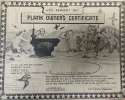 NS0308324 |
1.25M | Plank Owner's Certificate for LT(JG) Charles P. Weikel, USNR. |
Susan Weikel Morrison, daughter of LT Weikel |
|
| Ex-USS Sargent Bay |
||||
 NS0308303 |
59k | In reserve. South Boston Naval Annex, 1959. |
© Richard Leonhardt | |
 NS0308304 |
58k | As above. |
© Richard Leonhardt | |
|
||||
| Crew Contact and Reunion Information | ||||||||||||||||
|
| Main Photo Index |
Escort Carrier Photo Index Page |
Comments, Suggestions or Image submissions, E-mail Carrier Information
Problems and site related matters, E-mail Webmaster
This page was created by Paul Yarnall and is maintained by Fabio Peña
![]()
Last update: 31 August 2023